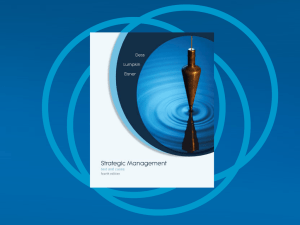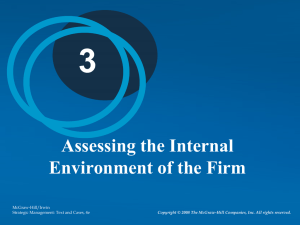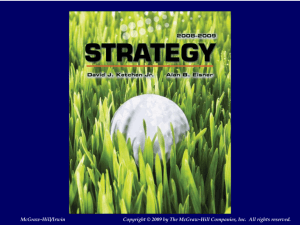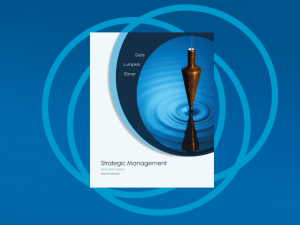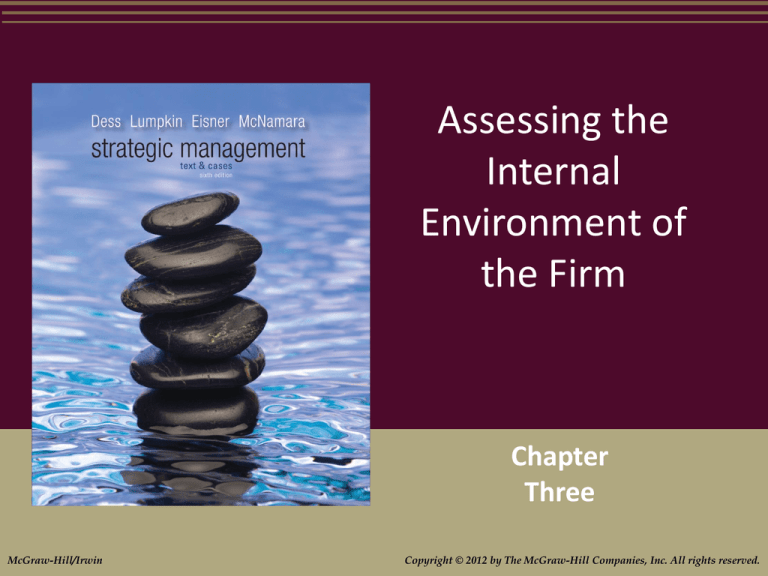
Assessing the
Internal
Environment of
the Firm
Chapter
Three
McGraw-Hill/Irwin
Copyright © 2012 by The McGraw-Hill Companies, Inc. All rights reserved.
Learning Objectives
After reading this chapter, you should have a good
understanding of:
LO3.1 The benefits and limitations of SWOT analysis in
conducting an internal analysis of the firm.
LO3.2 The primary and support activities of a firm’s value
chain.
LO3.3 How value-chain analysis can help managers create
value by investigating relationships among activities
within the firm and between the firm and its customers
and suppliers.
LO3.4 The resource-based view of the firm and the
different types of tangible and intangible resources, as
well as organizational capabilities.
3-2
Learning Objectives (cont.)
LO 3.5 The four criteria that a firm’s resources must
possess to maintain a sustainable advantage and
how value created can be appropriated by
employees.
LO 3.6 The usefulness of financial ratio analysis, its
inherent limitations, and how to make meaningful
comparisons of performance across firms.
LO 3.7 The value of the “balanced scorecard” in
recognizing how the interests of a variety of
stakeholders can be interrelated.
LO 3.8 How firms are using Internet technologies to add
value and achieve unique advantages. (Appendix)
3-3
The Limitations of SWOT Analysis
Strengths may not lead to an advantage
SWOT’s focus on the external environment is
too narrow
SWOT gives a one-shot view of a moving
target
SWOT overemphasizes a single dimension of
strategy
3-4
Value-Chain Analysis
Value-chain analysis
a strategic analysis of an organization that
uses value creating activities.
Value is the amount that buyers are willing
to pay for what a firm provides them and is
measured by total revenue
3-5
Value-Chain Analysis
Primary activities
contribute to the physical creation of the
product or service, its sale and transfer to the
buyer, and its service after the sale.
inbound logistics, operations, outbound
logistics, marketing and sales, and service
3-6
QUESTION
In assessing its primary activities, an airline
would examine:
A. Employee training programs
B. Baggage handling
C. Criteria for lease versus purchase decisions
D. The effectiveness of its lobbying activities
3-7
Value-Chain Analysis
Support activities
activities of the value chain that either add
value by themselves or add value through
important relationships with both primary
activities and other support activities
procurement, technology development,
human resource management, and general
administration.
3-8
The Value Chain
Exhibit 3.1
3-9
Primary Activity: Inbound Logistics
Associated with receiving, storing and
distributing inputs to the product
Location of distribution facilities
Warehouse layout
and designs
3-10
Primary Activity: Operations
Associated with transforming inputs into
the final product form
Efficient plant operations
Incorporation of appropriate process
technology
Efficient plant layout and workflow design
3-11
Primary Activity: Outbound Logistics
Associated with collecting, storing, and
distributing the product or service to
buyers
Effective shipping processes to provide quick
delivery and minimize damages
Shipping of goods in large lot sizes to
minimize transportation costs.
3-12
Primary Activity: Marketing and Sales
Associated with purchases of products
and services by end users and the
inducements used to get them to make
purchases
Innovative approaches to promotion and
advertising
Proper identification of customer segments
and needs
3-13
Primary Activity: Service
Associated with providing service to
enhance or maintain the value of the
product
Quick response to customer needs and
emergencies
Quality of service
personnel and
ongoing training
3-14
Support Activity: Procurement
Function of purchasing inputs used in the
firm’s value chain
Procurement of raw material inputs
Development of collaborative “win-win”
relationships with suppliers
Analysis and selection of alternate sources
of inputs to minimize dependence on one
supplier
3-15
Support Activity:
Human Resource Management
Activities involved in the recruiting, hiring,
training, development, and compensation
of all types of personnel
Effective recruiting, development, and
retention mechanisms for employees
Quality relations with trade unions
Reward and incentive programs to motivate
all employees
3-16
Support Activity:
Technology Development
Related to a wide range of activities and
those embodied in processes and
equipment and the product itself
Effective R&D activities for process and
product initiatives
Positive collaborative relationships between
R&D and other departments
Excellent professional qualifications of
personnel
3-17
Support Activity:
General Administration
Typically supports the entire value chain
and not individual activities
Effective planning systems
Excellent relationships with diverse
stakeholder groups
Effective information technology to integrate
value-creating activities
3-18
Interrelationships among Value-Chain Activities
within and across Organizations
Two levels
Interrelationships
among activities
within the firm
Relationships
among activities
within the firm and
with other
organization (e.g.,
customers and
suppliers)
3-19
Value Chains in Service Industries
Exhibit 3.4
3-20
Resource-Based View of the Firm
Resource-based view of the firm
perspective that firms’ competitive
advantages are due to their endowment of
strategic resources that are valuable, rare,
costly to imitate, and costly to substitute.
3-21
Resource-Based View of the Firm
Two perspectives
The internal analysis of phenomena within a
company
An external analysis of the industry and its
competitive environment
3-22
Types of Resources
Tangible resources
organizational assets that are relatively easy
to identify, including physical assets, financial
resources, organizational resources, and
technological resources.
3-23
Types of Resources
Intangible resources organizational
assets that are difficult to identify and
account for and are typically embedded in
unique routines and practices, including
human resources, innovation resources, and
reputation resources.
3-24
Types of Resources
Organizational
capabilities
The competencies
and skills that a firm
employs to
transform inputs into
outputs.
3-25
QUESTION
Gillette combines several technologies to attain
unparalleled success in the wet shaving industry.
This is an example of their
A. Tangible resources
B. Intangible resources
C. Organizational capabilities
D. Strong primary activities
3-26
Firm Resources and Sustainable
Competitive Advantages
First, the resource must be valuable in the
sense that it exploits opportunities and/or
neutralizes threats in the firm’s environment.
Second, it must be rare among the firm’s
current and potential competitors.
3-27
Firm Resources and Sustainable
Competitive Advantages
Third, the resource must be difficult for
competitors to imitate.
Fourth, the resource must have no
strategically equivalent substitutes.
3-28
Sources of Inimitability
Physical
uniqueness
Path dependency
Causal ambiguity
Social complexity
3-29
The Generation and Distribution of a Firm’s
Profits
Four factors help explain the extent to which
employees and managers will be able to obtain a
proportionately high level of the profits that they
generate
Employee bargaining power
Employee replacement cost
Employee exit costs
Manager bargaining power
3-30
Evaluating Firm Performance
Financial ratio
analysis
Balance sheet
Income statement
Historical
comparison
Comparison with
industry norms
Comparison with
key competitors
Stakeholder
perspective
Employees
Customers
Owners
3-31
Financial Ratio Analysis
Five types of financial ratios
Short-term solvency or liquidity
Long-term solvency measures
Asset management (or turnover)
Profitability
Market value
3-32
Financial Ratio Analysis
Historical comparisons
Comparison with industry norms
Comparison with key competitors
3-33
Five Types of Financial Ratios
3-34
The Balance Scorecard
Provides a meaningful integration of many
issues that come into evaluating a firm’s
performance
Four key perspectives
How do customers see us?
What must we excel at?
Can we continue to improve and create
value?
How do we look to shareholders?
3-35
Customer Perspective
Time
Quality
Performance and service
Cost
3-36
Internal Business Perspective
Processes
Decisions
Actions
Coordination
Resources and
capabilities
3-37
Innovation and Learning Perspective
Introduction of new products and services
Greater value for customers
Increased operating efficiencies
3-38
Financial Perspective
Profitability
Growth
Shareholder value
Increased market share
Reduced operating expenses
Higher asset turnover
3-39
Potential Limitations of the
Balanced Scorecard
Lack of a clear strategy
Limited or ineffective executive sponsorship
Too much emphasis on financial measures
rather than non-financial measures
Poor data on actual performance
Inappropriate links to scorecard measures to
compensation
Inconsistent or inappropriate terminology
3-40


